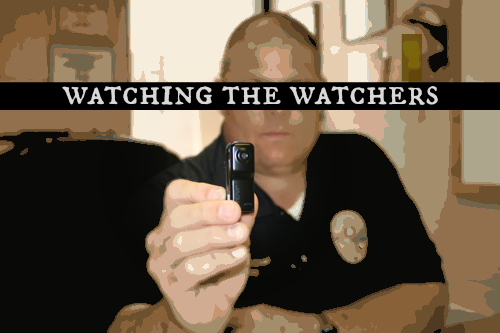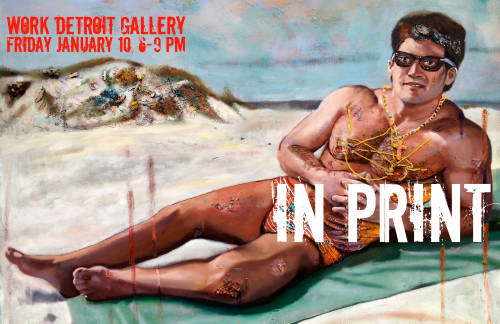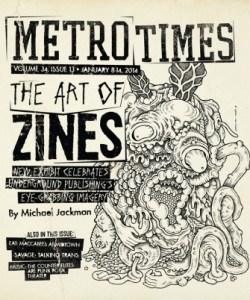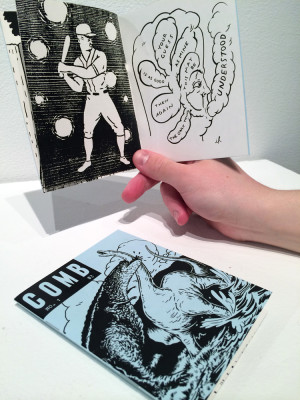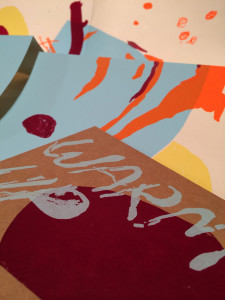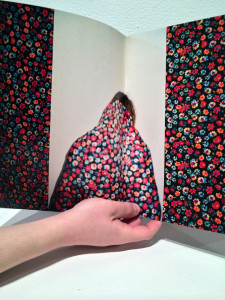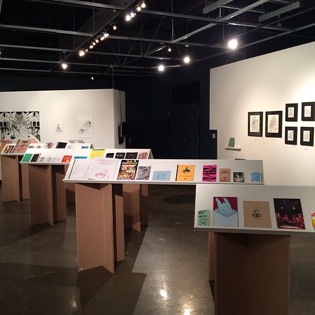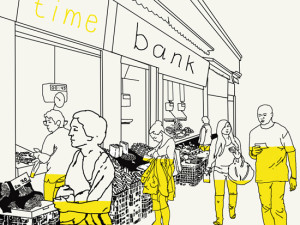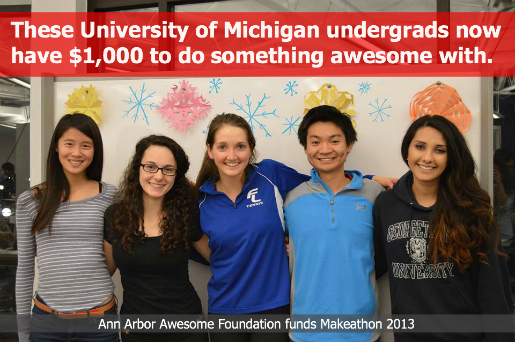
A few days ago, the Ann Arbor Awesome Foundation awarded $1,000 in cash to University of Michigan Mechanical Engineering undergraduate Beverly Chou (seen below accepting the award from A2 Awesome founder Lisa Dengiz) to help fund the launch of an event that she and fellow students are calling Makeathon. After our meeting, I took the opportunity to ask Beverly, and fellow event organizer Sydney Bigelow, a few questions about their plans.
MARK: Congratulations on winning your Ann Arbor Awesome Foundation grant… What can you tell us about your project?
SYDNEY: It’s an event called Makeathon. It’s an interdisciplinary product design competition that gives college students 36 hours to build a functional prototype of a self-designed product. Students will work in teams to blueprint their ideas, create their products using materials and prototyping technology (like 3-D printers), and pitch their ideas. The winning product will get the chance to be manufactured and sold.
MARK: To whom will the teams be pitching their ideas, and by what criteria will they be judged? Are you, for instance, looking for the item with the greatest potential for sales and profitability, or for the one that has the most potential to address an unmet need and accomplish good?
BEVERLY: We haven’t completely worked out all of the logistics, but we’re planning on having the teams pitch to a live public audience on Sunday, February 23rd. Later, we would like to post the top products online for everyone to browse. As for criteria, we are going to judge based on the execution of technical components, craftsmanship and manufacturability of the design, and whether the product meets a need. The more impactful the product is, the more likely it will be successful.
MARK: And the winning team gets assistance of some kind, financial or otherwise, should they want to pursue mass production, sales, etc?
BEVERLY: We will definitely direct students to the Center for Entrepreneurship here at the University of Michigan as well as other entrepreneurship accelerators and programs so they can continue developing their ideas if they so choose. We also hope to provide some prizes that will encourage students to form startups, or become a part of the Maker Movement.
MARK: When and where will Makeathon be held?
SYDNEY: It will begin on February 21st, and run through the 23rd.
BEVERLY: We’re currently planning on holding the event at TechShop, in Detroit.
MARK: What kinds of people would you like to have attend, and how should people who are interested go about signing up?
SYDNEY: Any college students who have an idea that they would like to create can participate. Although Makeathon has been targeting Engineering and Art & Design students, the competition is interdisciplinary. We want students from all majors and all disciplines to attend. One of our primary goals in hosting this competition is to promote collaboration between students from all backgrounds, majors, and interests; each person will add a unique perspective to the team, which will in turn lead to some of the most amazing projects!
BEVERLY: We think that product design naturally requires an interdisciplinary team. Art & Design and Engineering students will know how to build and visualize a product, while Business and Liberal Arts students will know how to showcase the value of the product. People who are interested in signing up can contact us at mpowered-make@umich.edu or see our website for more information.
MARK: By “students,” would I be right to assume that you mean undergraduates? And, if I’m not mistaken, we’re not just talking about U-M students, right?
BEVERLY: The event is open to both undergraduate and graduate students. We plan on opening the event to any of the nearby colleges in the Detroit and Ann Arbor area, and we are currently talking with people at the College of Creative Studies in Detroit.
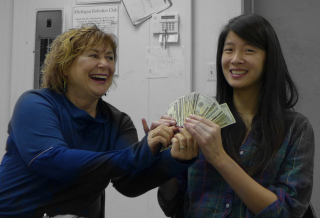 MARK: And participation is capped at 200?
MARK: And participation is capped at 200?
BEVERLY: Yes, we plan on having 40-50 teams. Each team will have 4-5 students.
MARK: Walk me through the 36 hours of the event… What do people do when they first walk in? I assume there’s training on the various 3D printers and other equipment, right? And then what? Do people have an opportunity to mingle, share their ideas, and find other like-minded individuals to team up with?
BEVERLY: We are still in the process of organizing everything, but, as of right now, the plan is to start the event on Friday night (February 21) with a brainstorming, idea-sharing, CAD designing session at the University of Michigan. Teams will get a chance to mix with other teams and come up with an idea they would like to pursue. If they’re pretty far along, they can even start making a CAD model of their design. Then students will go home, get a good night’s sleep, and wake up early to head to TechShop on Saturday. Once students get to Tech Shop, some students can take training so they can access specific workshops, while other students can continue to design and then build their ideas. Teams will continue to build into Sunday morning. And then we’ll clean up and move to another venue so students can pitch their products. We will announce the top teams and products at the end of the event, and then move everyone will return home.
MARK: So students from Detroit would come out to Ann Arbor for the first phase? …And are you encouraging people to attend as fully formed teams, right from the outset, or would it be OK if people showed up on their own, hoping to find team members on the 21st, which, I would think, would increase the chances of teams being cross-disciplinary?
SYDNEY: Students can attend in teams, or by themselves. If students arrive by themselves, we will place them on a team at the onset of the competition. Students who form teams beforehand will have the advantage of being acquainted with their teammates, while students who attend solo will have the advantage of meeting new people and making new connections.
MARK: Is there a participation fee?
BEVERLY: We want to make the event easy for participants to say “yes” to. We are aiming to make this free for students, but it’s possible we might have a small charge to help cover food.
MARK: Is there a specific challenge that all of the groups will be addressing, and, if so, will people be told what it is in advance?
SYDNEY: Yes, there will be a specific “theme” for Makeathon, that participants will be told in advance. This theme will be very broad; it’s not meant to limit the ideas that are generated, but merely to guide them. We figured that if students were given free reign and told to just, “build something!” it would be a little overwhelming.
MARK: When will the theme be made public?
BEVERLY: We’re planning on starting our marketing for the event sometime in the next few weeks, so look out for more details on the MPowered Makeathon Facebook page and Twitter!
MARK: And you’re both U-M undergrads? What are you studying?
BEVERLY:: I’m an undergraduate Mechanical Engineering major and an Art & Design minor.
SYDNEY: I’m a student in the College of Literature, Science, and the Arts, planning on majoring in Biology.
MARK: How did you come up with the idea to do this? Had you seen it attempted elsewhere?
BEVERLY:: I was inspired by hackathons where many of my computer science friends had gotten chances to meet other awesome coders from around the country, show off their skills outside of the classroom, and get hired by companies like Google and Facebook. Being someone who lacks coding skills, I was jealous that there was nothing similar for the rest of us that don’t have a big passion for hacking. Thus the idea for Makeathon came about as a competition for students from Engineering, Art & Design, Liberal Arts, and Business to collaborate and use their knowledge outside of the classroom to design physical products. We’re hoping that students will want to put projects from Makeathon in their portfolios to show their capabilities outside of an academic environment.
SYDNEY: Likewise, there are so many talented undergraduate students with amazing ideas – ideas that could be the basis of the next big start-ups in Michigan. We want to give those students the tools and the means necessary to take the first step in creating that next big product, or that next big business. Often, we see students with amazing ideas who are unsure of how to take the first step in turning those ideas into something tangible.
MARK: I may be completely wrong about this, but hackathons, it seems to me, are largely successful because they attract a great deal of financial support from industry. Tech companies, like Google and Facebook, contribute significant sums of money because they want to attend these events and have direct access to promising young coders. I’m curious if the same will hold true on the maker side of the equation… What kind of response are you getting from industry? Are they stepping up to help make this happen?
BEVERLY: Hackathons have gotten a lot of support because hackathons have been proven to be successful and an amazing source for talented coders. Since few college makeathons have occurred, we haven’t been able to point to any past events and tell big companies that the first ever MPowered Makeathon is going to be as successful and large-scale as a hackathon. However, makeathons are definitely an up and coming trend, and we think that they will be at the same scale and popularity of hackathons in the next few years. Based on my experience, we’ve found that smaller companies are much more excited to support us, especially those who are passionate about supporting the Maker Movement.
MARK: Have you found evidence of makeathons taking place elsewhere? And, if so, what have you learned from their experiences?
BEVERLY: Yes, there have been companies that have hosted their own internal makeathons. For instance, we’ve been inspired by a few of IDEO’s makeathons at their offices in Chicago, London, and Munich. Also, our friends at MIT are hosting an makeathon called Hardware Hacks in February as well.
MARK: How many people are on the team putting all of this together, and what are their backgrounds?
SYDNEY: There are five members on our team; two “core” directors, and three other “talent” members. I am freshman – a “talent” member who joined MPowered this year. The other two “talent” members are Phillip Yang, a freshman in the College of Engineering, and Liz Waldvogel, a sophomore also in the College of Engineering.
BEVERLY: As the core directors, Soona and I did most of the visioning to decide the mission, goals, and scale of the event. We also act as project managers and oversee the team’s activities. We’re pretty much responsible for making sure Makeathon happens!
MARK: And you all came to know one another through the student entrepreneurship group MPowered?
BEVERLY: Yes, our umbrella organization, MPowered Entrepreneurship, recruits for talent members at the beginning of every semester. Soona and I met Sydney, Liz, and Phillip during this time and chose them to be a part of the team.
MARK: How will you be handling transportation to and from Ann Arbor?
BEVERLY: We are planning busing students between Ann Arbor and Detroit.
MARK: How exactly will the $1,000 you received today from the Ann Arbor Awesome Foundation be put to use?
SYDNEY: The money will go towards paying for materials, such as wood, plastics, metals, and various tools. Likewise, part of the money will be spent on food for the participants. We want to make sure that all necessities are taken care of so that participants can focus on building the most amazing products!
MARK: I’m curious as to how you heard about the Awesome Foundation…
SYDNEY: I found it while searching the internet, actually. When we first started planning Makeathon I was looking online for grants in the Ann Arbor Area. The Awesome Foundation came up, and the more I read about it, the more I was like, “This foundation is just…awesome.” So I applied, and here we are now.
MARK: So, what still needs to happen in order for this to become a reality?
BEVERLY: We still need to fundraise and gain more support so we can provide materials and food for our all of our participants. We also need to start getting the word out to students in the Ann Arbor and Detroit areas, so we can bring 200 awesome students to the Makeathon!
MARK: What’s the most awesome thing possible that could come out of this?
BEVERLY: Our dream is to have students form amazing physical product or hardware startups that sell beautiful and wildly popular products. We want to be an inspiration to students and show them that entrepreneurship is not exclusive to programmers, and we hope to see more Makeathons, maker spaces, and maker enthusiasts pop up in the next few years!

